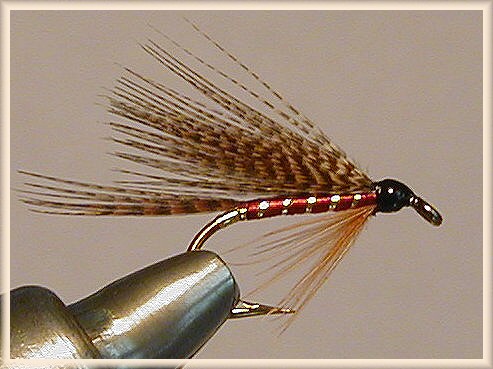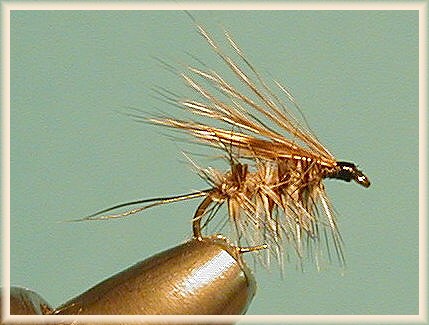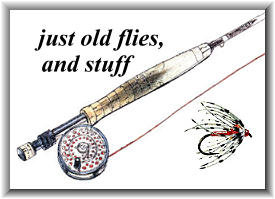This article was put together initially
simply as an excuse to feature Andy Brasko's
beautifully tied Grizzly King. Andy sent this
to me along with The Captain, and I was so
impressed I just had to put it up on the site.
But the Grizzly King had been done in a previous
article, so what to do? Then it hit me. What
about all the other "Kings? I could, off the
top of my head, come up with four, the ones
featured here. There are others, Kingfisher
and Kingdom to name two. But these will have
to do for now. Another friend, Don Shipp, has
helped out here with a fine tie of the Colorado
King.

The Grizzly King
Fly Tied by Andy Brasko
This fly was done in a previous article, you'll find the
history and recipe
HERE. I'm struck by how many times this fly
is listed as a favorite in letters to Mary Orvis
Marbury and J. Edson Leonard, in their respective
books. This fly is a great one, and still used today.
Andy Brasko's version of the fly is a great one as well.

The Rio Grande King
Fly Tied by Eric Austin
This is a fly I remember well from my youth, whose name
evokes the Mexican border. The fly, in both yellow
and black patterns, was originated and first tied by Jim Douglas,
Of Denver, Colorado. Among other patterns of his are the
Gunnison and the Western Bee - a red striped version of the
McGinty. J. Edson Leonard shows no less than four
patterns for this fly, as well as one for the Rio
Grande Queen, giving you an idea of the fly's
popularity. What I find interesting though is
that there is a nearly identical fly from British
Columbia called "The Lioness." The only difference
is the hackle and tail have red hackles mixed in,
giving a more orange tint to the fly. The Lioness
was developed in the 40s, so the Rio Grande King
predates it, as it shows up in "Trout" in 1938. It
just shows how a good idea gets around. Here are
some recipes for "The Rio Grande King":
Rio Grande King #1 (shown above)
Tail: Yellow.
Body: Black chenille, gold tip.
Hackle: Yellow.
Wing: White Mallard or Goose.
Rio Grande King #2
Tail: Golden pheasant tippet.
Body: Black chenille, gold tip.
Hackle: Brown.
Wing: White Mallard or Goose.
Rio Grande King #3
(The one I remember from the '60s)
Tail: Red Hackle.
Body: Black chenille, gold tip.
Hackle: Brown.
Wing: White Mallard or Goose.
Rio Grande King Special
Tail: Golden pheasant tippet.
Body: Brown fore, yellow aft, floss.
Hackle: Brown
Wing: White Mallard or Goose.

The King of the Waters
Fly Tied by Eric Austin
-
The King of the Water shown in Mary Orvis
Marbury's book (late 1800s) has no tail. By
the time we get to Trout by Ray
Bergman, the fly has grown one. It's name has
also changed slightly to "King of Waters" and
by J. Edson Leonard's book in 1950, to the one
I recognize, "King of the Waters." This is one
of those flies that is so old that its origins
are lost to the annals of history. As Mary Orvis
Marbury puts it in Favorite Flies and their
Histories:
-
"The King of the Water dates back of
"the three brothers that came over in the Mayflower,"
and is an old, well-known fly that has outlived
its records. When it was first used, and by whom
it was named, we cannot say; but it ranks well
with the Professor, Grizzly King, Great Dun, Red
Hackle, and other flies known to all anglers."
-
The recipe's listed for the "King of the Waters"
by J. Edson Leonard are as follows:
King of Waters #1 (Mary Orvis Marbury's version)
Tip: Silver tinsel.
Body: Scarlet floss.
Ribbing: Silver tinsel.
Hackle: Brown palmer.
Wing: Mallard.
King of Waters #2 (Bergman, shown here)
Tip: Gold tinsel.
Tail: Mallard.
Body: Scarlet floss.
Ribbing: Silver Tinsel.
Hackle: Brown.
Wing: Mallard.

The Colorado King
Fly Tied by Don Shipp
-
I'm not sure that this caddis pattern belongs
with these wets, but it is a 'King' after all.
I was very much helped out by T. Hellekson with
patterns and history for this fly. Don Shipp
sent me a fine picture of a great version of
the light Colorado King that he tied for a swap.
Here's what T. Hellekson had to say in a recent
email to me:
-
"I featured these patterns in my first book,
Popular Fly Patterns (1976) and
they still find a place in many fly boxes.
Colorado King, Brown
Hooks: MUSR50, TMC100 or DAI1170, sizes 6-18.
Thread: Brown.
Tail: Two dark moose hairs tied split.
Hackle: Brown tied palmer-style over the body.
Body: Dubbed with brown synthetic fur.
Wing: Dark elk hair tied over the body.
Colorado King, Dark
Hooks: MUSR50, TMC100 or DAI1170, sizes 6-18.
Thread: Black.
Tail: Two dark moose hairs tied split.
Hackle: Grizzly tied palmer-style over the body.
Body: Dubbed with muskrat fur.
Wing: Dark elk hair tied over the body.
Colorado King, Dark Female
Tied same as the Dark Colorado King except a
dubbed yellow rabbit fur egg sac is tied in
at the rear of the body.
Colorado King, Light
Hooks: MUSR50, TMC100 or DAI1170, sizes 6-18.
Thread: Gray.
Tail: Two dark moose hairs tied split.
Hackle: Light case grizzly tied palmer-style
over the body.
Body: Dubbed with yellow synthetic fur.
Wing: Light elk hair tied over the body.
-
George Bodmer of Colorado Springs, Colorado,
originated the Colorado Kings. I seriously
doubt if he knew he was giving us something
of such long lasting value.
-
Originally these flies were not tied with the
express purpose of simulating a caddis of any
sort. They were what George considered to be
his meat and potatoes and he wasn't all that
sure why they were so darn effective. I believe
the tail on these flies may have initially
dampened the interests of some anglers, as
the inclusion of tails is not usually adapted
for caddisfly imitations. I look upon them as
stabilizers giving better balance to the fly on
fast, rough water. I doubt that the fish have
little opportunity to examine this minor feature.
The tails on these flies are mounted on each side
of the body with the aid of a small ball of dubbed
body material." ~ T. Hellekson
~ Eric Austin
Credits: Popular Fly Patterns by T.
Hellekson; Trout by Ray Bergman; Favorite
Flies and their Histories by Mary Orvis Marbury;
Flies by J. Edson Leonard; Fly Patterns
of British Columbia by Arthur James Lingren.
|



